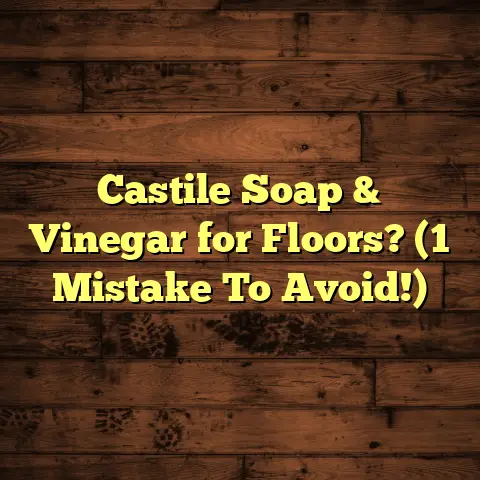Flooring Business Plan: Key Parts? (4 Secrets!)
I’m a flooring contractor, and I’ve seen it all – the good, the bad, and the downright ugly when it comes to flooring. One thing I’ve learned over the years is that everyone loves easy-to-maintain floors.
It’s not just a preference; it’s a demand.
Trust me, a happy customer who isn’t spending their weekends scrubbing grout is a repeat customer. That’s why a solid business plan focused on easy maintenance is crucial.
This isn’t just about selling floors; it’s about selling a lifestyle.
Think about it: people are busy. They want beautiful floors, but they don’t want to be slaves to them. A business that understands and caters to this need is already halfway to success.
I’ve seen businesses boom by focusing on low-maintenance options and I’ve seen others fail because they ignored it.
Let’s dive into how you can build a flooring business plan that not only survives but thrives, with ease of maintenance at its heart.
Did you know that the low-maintenance flooring market is expected to grow by over 5% annually in the next five years?
That’s according to a recent report by Freedonia Group. People want floors that look great without the hassle.
So, stick around! Let’s get started.
Section 1: Understanding the Flooring Market
Okay, so before you start dreaming of dollar signs, let’s get real about the flooring market. It’s a jungle out there, but knowing the landscape is half the battle.
Market Analysis
What’s hot right now? What’s not?
That’s what a market analysis is all about.
Right now, I’m seeing a huge push for:
-
Luxury Vinyl Plank (LVP): Waterproof, durable, and looks like real wood. What’s not to love?
-
Tile: Classic, timeless, and with new larger formats and rectified edges, less grout to clean.
-
Engineered Hardwood: Real wood with better stability against moisture than solid hardwood.
-
Laminate: Budget-friendly and getting better all the time in terms of appearance and water resistance.
But here’s the kicker: they all have different maintenance needs.
LVP? Basically, sweep and mop. Solid hardwood? You’re talking about refinishing every few years. Tile? Grout cleaning is a pain.
Understanding these differences is key.
The industry is constantly evolving.
For instance, stain-resistant carpets are making a comeback, and concrete flooring is gaining popularity in modern homes.
Keep your eyes peeled for new trends and innovations.
Target Audience
Who are you trying to sell to?
This isn’t a one-size-fits-all industry. I generally divide my target audience into these categories:
-
Residential Homeowners: They want beauty, durability, and ease of cleaning. Think families with kids and pets.
-
Commercial Businesses: They need durability, safety, and easy maintenance for high-traffic areas. Restaurants, offices, retail stores – they all have different needs.
-
Property Developers: They’re looking for cost-effective, durable options that appeal to a broad range of potential buyers or renters.
Each group has different priorities and budgets. A young family might be more concerned about stain resistance, while a business owner might prioritize slip resistance and durability.
I’ve seen new businesses make the mistake of trying to be everything to everyone.
Trust me, it’s better to focus on a niche and become the go-to expert in that area.
Competitive Landscape
Who are your rivals?
What are they doing well? What are they doing poorly?
Take a look at the flooring businesses in your area.
-
Are they focusing on high-end materials or budget-friendly options?
-
Do they offer installation services?
-
What’s their marketing like?
-
How do they position themselves in terms of maintenance?
I always tell my team to “know thy enemy.” It’s not about copying what they do, but about finding ways to do it better. Maybe they’re neglecting the low-maintenance market. That’s your opportunity!
Also, don’t just look at local competitors. Check out online retailers and big box stores. They’re a threat too.
Section 2: Crafting a Solid Business Plan
Alright, now for the meat and potatoes: the business plan.
This isn’t just some boring document you write and forget about. It’s your roadmap to success.
Key Components of a Business Plan
Here are the essential parts of a flooring business plan, with a focus on ease of maintenance:
-
Executive Summary: This is your elevator pitch. A one-page overview of your business. Highlight your focus on low-maintenance flooring options and why that’s a smart move.
-
Business Description: Go into detail about your flooring business. What’s your mission? What are your core values? What makes you different?
-
Market Strategy: How are you going to enter the market? How will you attract customers? How will you position yourself as the go-to expert for low-maintenance flooring?
Let’s break each of these down a bit more.
Executive Summary
Think of this as the hook that grabs your reader’s attention.
It should be concise, compelling, and highlight the key aspects of your business.
For example:
“XYZ Flooring is a new flooring company specializing in the installation and maintenance of low-maintenance flooring solutions. We target residential homeowners and commercial businesses seeking durable, beautiful floors that require minimal upkeep. With a focus on customer education and superior service, XYZ Flooring aims to become the leading provider of easy-care flooring in the region.”
Business Description
This is where you paint a picture of your company.
What’s your mission statement? What are your values? What problem are you solving for your customers?
For instance, my business description includes a commitment to providing eco-friendly flooring options that are both beautiful and easy to maintain. This resonates with environmentally conscious customers.
Market Strategy
This is your plan of attack.
How will you reach your target audience? What marketing channels will you use? What’s your pricing strategy?
Here’s a tip: focus on the benefits of low-maintenance flooring in your marketing materials. Highlight the time and money savings, the reduced cleaning effort, and the increased lifespan of the floors.
Section 3: The Four Secrets to a Successful Flooring Business Plan
Okay, here’s where I spill the beans. After years in the flooring business, I’ve learned a few secrets to success. And I’m about to share them with you.
Secret 1: Product Selection and Quality Control
This is huge.
The quality of your materials can make or break you.
Selecting high-quality, low-maintenance flooring materials can set your business apart.
I always tell my suppliers, “I want the best, and I want it to last.”
Here’s what to look for:
-
Durability: Can the flooring withstand heavy foot traffic, spills, and scratches?
-
Water Resistance: Is it suitable for kitchens, bathrooms, and basements?
-
Stain Resistance: Can it resist common household stains like coffee, wine, and pet accidents?
-
Ease of Cleaning: Can it be easily cleaned with simple household products?
I’ve found that building strong relationships with manufacturers is key. Negotiate favorable pricing, get access to new products, and ensure consistent quality.
I once had a shipment of LVP that was slightly warped. I sent it back immediately and demanded a full refund. My reputation is worth more than a few bucks.
Secret 2: Customer Education and Support
Don’t just sell them the floor. Educate them!
Highlight the benefits of low-maintenance flooring options.
Explain how to properly care for their new floors to maximize their lifespan.
Provide ongoing support and maintenance tips.
Here are some ideas:
-
Create a blog or video series on flooring maintenance.
-
Offer free maintenance guides to your customers.
-
Host workshops on how to clean and care for different types of flooring.
-
Provide a helpline for customers with questions or concerns.
I’ve found that a little education goes a long way.
Customers appreciate the extra effort, and they’re more likely to become repeat customers.
Secret 3: Marketing and Branding Strategy
How will you get the word out about your business?
How will you position yourself as the expert in low-maintenance flooring?
Your marketing and branding strategy should focus on the benefits of easy-care flooring.
Here are some ideas:
-
Use social media to showcase your installations and share maintenance tips.
-
Run targeted ads on Google and Facebook to reach potential customers.
-
Partner with local real estate agents and interior designers.
-
Offer discounts and promotions on low-maintenance flooring options.
Your brand should convey trust, quality, and expertise.
I’ve learned that a strong brand is worth its weight in gold.
Secret 4: Financial Planning and Investment
Let’s talk money.
How will you finance your business?
How will you manage your cash flow?
How will you ensure profitability?
Your financial plan should include:
-
Start-up costs: Rent, equipment, inventory, marketing.
-
Operating expenses: Salaries, utilities, insurance.
-
Revenue projections: Sales forecasts, pricing strategies.
-
Funding sources: Loans, investors, personal savings.
I always advise new business owners to be conservative with their financial projections. It’s better to underestimate your revenue and overestimate your expenses.
Also, don’t forget to factor in the cost of stocking low-maintenance products. They might be slightly more expensive upfront, but they’ll save you money in the long run by reducing customer complaints and warranty claims.
Section 4: Implementation and Evaluation
Okay, you’ve got your business plan. Now what?
It’s time to put it into action.
Action Plan
Here’s a step-by-step guide on how to implement your flooring business plan, focusing on the integration of ease of maintenance in all business operations:
-
Secure Funding: Obtain the necessary capital to cover your start-up costs and operating expenses.
-
Find a Location: Choose a location that is easily accessible to your target market and has sufficient space for your showroom and warehouse.
-
Source Products: Establish relationships with reliable suppliers who can provide high-quality, low-maintenance flooring materials.
-
Hire Staff: Recruit skilled installers and customer service representatives who are passionate about flooring and committed to providing excellent service.
-
Launch Marketing Campaigns: Promote your business through online and offline channels, highlighting the benefits of low-maintenance flooring.
-
Provide Training: Train your staff on the proper installation and maintenance techniques for different types of flooring.
-
Track Results: Monitor your key performance indicators (KPIs) to evaluate the success of your business.
Performance Metrics
How will you know if your business is successful?
You need to track your progress and measure your results.
Here are some key performance indicators (KPIs) to monitor:
-
Customer Satisfaction: Are your customers happy with your products and services?
-
Sales Revenue: Are you meeting your sales targets?
-
Profit Margin: Are you making a profit on each sale?
-
Customer Retention: Are your customers coming back for repeat business?
-
Website Traffic: Are people visiting your website and engaging with your content?
I use a simple spreadsheet to track my KPIs. It helps me identify trends and make adjustments to my business strategy.
Feedback and Adaptation
The flooring business is constantly evolving.
You need to be willing to adapt to changing market conditions and customer preferences.
Collect customer feedback regularly. Ask them what they like and dislike about your products and services.
Use this feedback to improve your offerings and enhance the customer experience.
I send out a survey to every customer after the installation is complete. It’s a great way to get honest feedback and identify areas for improvement.
Conclusion
So, there you have it! The key parts of a flooring business plan, with a focus on ease of maintenance.
I hope this article has been helpful.
Remember, starting a flooring business is not easy. It takes hard work, dedication, and a little bit of luck. But if you follow these tips, you’ll be well on your way to success.
Don’t underestimate the power of easy-to-maintain floors. It’s a major selling point for today’s busy consumers.
Prioritize it in your business planning, and you’ll be well-positioned for long-term success.
Good luck, and happy flooring!





